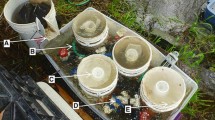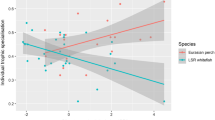Abstract
Climate change is altering temperatures and precipitation patterns all over the world. In Patagonia, Argentina, predicted increase in precipitation together with rapidly melting glaciers increase the surface runoff, and thereby the transport of suspended solids to recipient lakes. Suspended solids affect the visual conditions in the water which in turn restricts visual foraging. The native fish Aplochiton zebra Jenyns, and its filter-feeding cladoceran prey, Daphnia commutata Ekman, were subjected to foraging experiments at three turbidity levels. A. zebra foraging rate was substantially reduced at naturally occurring turbidity levels and the filtering rate of D. commutata was reduced at the highest turbidity level. This indicates that Daphnia may be partly released from predation from A. zebra at the same time as it can maintain relatively high feeding rates as turbidity increases. Lower foraging rates at the same time as the metabolic demand increases, through increased temperatures, may result in larger effects on A. zebra than could be expected from increases in turbidity or temperature alone. Turbidity may, as an indirect effect of climate change, decrease planktivore foraging rates and thereby alter the interaction strength between trophic levels.


Similar content being viewed by others
References
Arruda, J. A., G. R. Marzolf & R. T. Faulk, 1983. The role of suspended sediments in the nutrition of zooplankton in turbid reservoirs. Ecology 64: 1225–1235.
Baigun, C. & R. Ferriz, 2003. Distribution patterns of native freshwater fishes in Patagonia (Argentina). Organisms Diversity & Evolution 3: 151–159.
Boehlert, G. W. & J. B. Morgan, 1985. Turbidity enhances feeding abilities of larval Pacific herring, Clupea harengus pallasi. Hydrobiologia 123: 161–170.
Bottrell, H. H., A. Duncan, Z. M. Gliwicz, E. Grygierek, A. Herzig, A. Hillbricht-Ilkowska, H. Kurasawa, P. Larsson & T. Weglenska, 1976. Review of some problems in zooplankton production studies. Norwegian Journal of Zoology 24: 419–456.
Bruton, M. N., 1985. The effect of suspensoids on fish. Hydrobiologia 125: 221–241.
Chapman, W. M., 1944. On the osteology and relationships of the South American fish, Aplochiton zebra Jenyns. Journal of Morphology (Philadelphia) 75: 149–165.
Chesney, E. J., 1989. Estimating the food-requirements of striped bass larvae Morone saxatilis: effects of light, turbidity and turbulence. Marine Ecology-Progress Series 53: 191–200.
Clarke, A. & N. M. Johnston, 1999. Scaling of metabolic rate with body mass and temperature in teleost fish. Journal of Animal Ecology 68: 893–905.
Cussac, V., S. Ortubay, G. Iglesias, D. Milano, M. E. Lattuca, J. P. Barriga, M. Battini & M. Gross, 2004. The distribution of South American galaxiid fishes: the role of biological traits and post-glacial history. Journal of Biogeography 31: 103–121.
Engström-Öst, J. & J. Mattila, 2008. Foraging, growth and habitat choice in turbid water: an experimental study with fish larvae in the Baltic Sea. Marine Ecology-Progress Series 359: 275–281.
Fryxell, J. M. & P. Lundberg, 1998. Individual behavior and community dynamics. Chapman & Hall, New York.
Gille, S. T., 2002. Warming of the Southern Ocean since the 1950s. Science 295: 1275–1277.
Granqvist, M. & J. Mattila, 2001. The effects of turbidity and light intensity on the consumption of mysids by juvenile perch (Perca fluviatilis L.). In 17th Baltic Marine Biologists Symposium. Kluwer Academic Publisher, Stockholm: 93–101.
Gregory, R. S. & T. G. Northcote, 1993. Surface, planktonic, and benthic foraging by juvenile Chinook salmon (Oncorhynchus tshawytscha) in turbid laboratory conditions. Canadian Journal of Fisheries and Aquatic Sciences 50: 233–240.
Hansson, L. A., A. Nicolle, J. Brodersen, P. Romare, P. A. Nilsson, C. Brönmark & C. Skov, 2007. Consequences of fish predation, migration, and juvenile ontogeny on zooplankton spring dynamics. Limnology and Oceanography 52: 696–706.
IPCC, 2007. Climate Change 2007: synthesis report. In Pachauri, R. K. & A. Reisinger (eds), Contribution of Working Groups I, II and III to the Fourth Assessment Report of the Intergovernmental Panel on Climate Change: 104.
Jenyns, L., 1842. Fish, Part 4. In Darwin, C. (ed.), The Zoology of the Voyage of H.M.S. Beagle, under the command of Captain Fitzroy, R. N. during the years 1832 to 1836. Smith, Elder, and Co, London.
Kirk, K. L., 1991a. Suspended clay reduces Daphnia feeding rate - Behavioral mechanisms. Freshwater Biology 25: 357–365.
Kirk, K. L., 1991b. Inorganic particles alter competition in grazing plankton—the role of selective feeding. Ecology 72: 915–923.
Kirk, K. L., 1992. Effects of suspended clay on Daphnia body growth and fitness. Freshwater Biology 28: 103–109.
Lattuca, M. E., S. Ortubay, M. A. Battini, J. P. Barriga & V. E. Cussac, 2007. Presumptive environmental effects on body shape of Aplochiton zebra (Pisces, Galaxiidae) in northern Patagonian lakes. Journal of Applied Ichthyology 23: 25–33.
Lattuca, M. E., D. Brown, L. Castineira, M. Renzi, C. Luizon, J. Urbanski & V. Cussac, 2008. Reproduction of landlocked Aplochiton zebra Jenyns (Pisces, Galaxiidae). Ecology of Freshwater Fish 17: 394–405.
Lehman, J. T. & C. D. Sandgren, 1985. Species-specific rates of growth and grazing loss among fresh-water algae. Limnology and Oceanography 30: 34–46.
Liljendahl-Nurminen, A., J. Horppila & W. Lampert, 2008. Physiological and visual refuges in a metalimnion: an experimental study of effects of clay turbidity and an oxygen minimum on fish predation. Freshwater Biology 53: 945–951.
Lima, S. L., 1998. Nonlethal effects in the ecology of predator-prey interactions: what are the ecological effects of anti-predator decision-making? Bioscience 48: 25–34.
Lind, O. T. & L. Davaloslind, 1991. Association of turbidity and organic carbon with bacterial abundance and cell size in a large, turbid, tropical lake. Limnology and Oceanography 36: 1200–1208.
McDowall, R. M., 1969. A juvenile of Aplociton Jenyns. Copeia 1969: 631–632.
McDowall, R. M. & K. Nakaya, 1987. Identity of the Galaxioid fishes of the genus Aplochiton Jenyns from Southern Chile. Japanese Journal of Ichthyology 34: 377–383.
McDowall, R. M. & K. Nakaya, 1988. Morphological divergence in the two species of Aplochiton Jenyns (Salmoniformes: Aplochitonidae): a generalist and a specialist. Copeia 1988: 233–236.
McDowall, R. M. & N. W. Pankhurst, 2005. Loss of negative eye-size allometry in a population of Aplochiton zebra (Teleostei : Galaxiidae) from the Falkland Islands. New Zealand Journal of Zoology 32: 17–22.
Miner, J. G. & R. A. Stein, 1996. Detection of predators and habitat choice by small bluegills: Effects of turbidity and alternative prey. Transactions of the American Fisheries Society 125: 97–103.
Modenutti, B. E., E. G. Balseiro & P. M. Cervellini, 1993. Effect of the selective feeding of Galaxias maculatus (Salmoniformes, Galaxiidae) on zooplankton of a South Andes lake. Aquatic Sciences 55: 65–75.
Moore, R. D., S. W. Fleming, B. Menounos, R. Wheate, A. Fountain, K. Stahl, K. Holm & M. Jakob, 2009. Glacier change in western North America: influences on hydrology, geomorphic hazards and water quality. Hydrological Processes 23: 42–61.
Northcote, T. G., 1988. Fish in the structure and function of fresh-water ecosystems—a top-down view. Canadian Journal of Fisheries and Aquatic Sciences 45: 361–379.
Pascual, M. A., V. Cussac, B. Dyer, D. Soto, P. Vigliano, S. Ortubay & P. Macchi, 2007. Freshwater fishes of Patagonia in the 21st Century after a hundred years of human settlement, species introductions, and environmental change. Aquatic Ecosystem Health & Management 10: 212–227.
Piacentino, G. L. M., 1999. New geographic localities of Aplochiton species (Salmoniformes : Aplochitonidae) in the Argentinian Patagonia. Cybium 23: 209–211.
Rice, W. R., 1989. Analyzing tables of statistical tests. Evolution 43: 223–225.
Rignot, E., A. Rivera & G. Casassa, 2003. Contribution of the Patagonia Icefields of South America to sea level rise. Science 302: 434–437.
Steel, E. A. & S. Neuhausser, 2002. Comparison of methods for measuring visual water clarity. Journal of the North American Benthological Society 21: 326–335.
Stuart-Smith, R. D., J. F. Stuart-Smith, R. W. G. White & L. A. Barmuta, 2007. The effects of turbidity and complex habitats on the feeding of a galaxiid fish are clear and simple. Marine and Freshwater Research 58: 429–435.
Utne, A. C. W., 1997. The effect of turbidity and illumination on the reaction distance and search time of the marine planktivore Gobiusculus flavescens. Journal of Fish Biology 50: 926–938.
Utne-Palm, A. C., 1999. Visual feeding of fish in a turbid environment: Physical and behavioural aspects. In Conference on Vision and the Behavior of Marine Animals. Taylor & Francis Ltd, Oristano: 111–128.
Vinyard, G. L. & W. J. O’brien, 1976. Effects of light and turbidity on reactive distance of bluegill (Lepomis macrochirus). Journal of the Fisheries Research Board of Canada 33: 2845–2849.
Young, K. A., J. Stephenson, A. Terreau, A. F. Thailly, G. Gajardo & C. G. de Leaniz, 2009. The diversity of juvenile salmonids does not affect their competitive impact on a native galaxiid. Biological Invasions 11: 1955–1961.
Acknowledgments
This work was financed by Helge Ax:son Johnsson foundation, Sweden, Laboratorio de Limnologia, INIBIOMA, CONICET-Universidad Nacional del Comahue, Argentina, and the Limnology section at the Department of Ecology, Lund University, Sweden. All experiments were in compliance with local law.
Author information
Authors and Affiliations
Corresponding author
Additional information
Handling editor: M. Power
Rights and permissions
About this article
Cite this article
Jönsson, M., Ranåker, L., Nicolle, A. et al. Glacial clay affects foraging performance in a Patagonian fish and cladoceran. Hydrobiologia 663, 101–108 (2011). https://doi.org/10.1007/s10750-010-0557-4
Received:
Revised:
Accepted:
Published:
Issue Date:
DOI: https://doi.org/10.1007/s10750-010-0557-4




